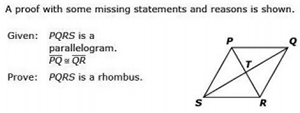General Information
Clusters should not be sorted from Major to Supporting and then taught in that order. To do so would strip the coherence of the mathematical ideas and miss the opportunity to enhance the major work of the grade with the supporting clusters.
Test Item Specifications
Items may require the student to be familiar with similarities and
differences between types of parallelograms (e.g., squares and
rectangles).
Items may require the student to identify a specific parallelogram.
Items may assess theorems and their converses for opposite sides of
a parallelogram, opposite angles of a parallelogram, diagonals of a
parallelogram, and consecutive angles of a parallelogram.
Items may assess theorems and their converses for rectangles and
rhombuses.
Items may include narrative proofs, flow-chart proofs, two-column
proofs, or informal proofs.
In items that require the student to justify, the student should not be
required to recall from memory the formal name of a theorem.
Neutral
Students will prove theorems about parallelograms.
Students will use properties of parallelograms to solve problems.
Items may be set in real-world or mathematical context.
Items may require the student to classify a quadrilateral as a
parallelogram based on given properties or measures.
Items may require the student to prove that a quadrilateral is a
parallelogram
Sample Test Items (1)
| Test Item # | Question | Difficulty | Type |
| Sample Item 1 |  Drag the correct statement from the statements column and the correct reasons from the reasons column to the table to complete line 3 of the proof. |
N/A | DDHT: Drag-and-Drop Hot Text |
Related Courses
| Course Number1111 | Course Title222 |
| 1200400: | Foundational Skills in Mathematics 9-12 (Specifically in versions: 2014 - 2015, 2015 - 2022, 2022 - 2024, 2024 and beyond (current)) |
| 1206310: | Geometry (Specifically in versions: 2014 - 2015, 2015 - 2022, 2022 - 2024, 2024 and beyond (current)) |
| 1206320: | Geometry Honors (Specifically in versions: 2014 - 2015, 2015 - 2022, 2022 - 2024, 2024 and beyond (current)) |
| 1206315: | Geometry for Credit Recovery (Specifically in versions: 2014 - 2015, 2015 - 2022, 2022 - 2024, 2024 and beyond (current)) |
| 7912065: | Access Geometry (Specifically in versions: 2015 - 2022, 2022 and beyond (current)) |
Related Resources
Formative Assessments
| Name | Description |
| Comparing Lengths in a Parallelogram | Students are given parallelogram ABCD along with midpoint E of diagonal AC and are asked to determine the relationship between the lengths AE + ED and BE + EC. |
| Finding Angle C | Students are given expressions that represent the measures of two angles of a parallelogram and are asked to find the measure of an angle opposite one of the given angles. |
| Frame It Up | Students are asked to explain how to determine whether a four-sided frame is a rectangle using only a tape measure. |
| Two Congruent Triangles | Students are asked to explain why a pair of triangles formed by the sides and diagonals of a parallelogram are congruent. |
| Angles of a Parallelogram | Students are given expressions that represent the measures of two angles of a parallelogram and are asked to find the measures of all four angles describing any theorems used. |
| Proving Congruent Diagonals | Students are asked to prove that the diagonals of a rectangle are congruent. |
| Proving a Rectangle Is a Parallelogram | Students are asked to prove that a rectangle is a parallelogram. |
| Proving Parallelogram Angle Congruence | Students are asked to prove that opposite angles of a parallelogram are congruent. |
| Proving Parallelogram Diagonals Bisect | Students are asked to prove that the diagonals of a parallelogram bisect each other. |
| Proving Parallelogram Side Congruence | Students are asked to prove that opposite sides of a parallelogram are congruent. |
Lesson Plans
| Name | Description |
| To Be or Not to Be a Parallelogram | Students apply parallelogram properties and theorems to solve real world problems. The acronym, P.I.E.S. is introduced to support a problem solving strategy, which involves drawing a Picture, highlighting important Information, Estimating and/or writing equation, and Solving problem. |
| Diagonally Half of Me! | This lesson is an exploration activity assisting students prove that diagonals of parallelograms bisect each other. It allows them to compare other quadrilaterals with parallelograms in order to make conjectures about the diagonals of parallelograms. |
| Proving Parallelograms Algebraically | This lesson reviews the definition of a parallelogram and related theorems. Students use these conditions to algebraically prove or disprove a given quadrilateral is a parallelogram. |
| Evaluating Statements About Length and Area | This lesson unit is intended to help you assess how well students can understand the concepts of length and area, use the concept of area in proving why two areas are or are not equal and construct their own examples and counterexamples to help justify or refute conjectures. |
Problem-Solving Task
| Name | Description |
| Midpoints of the Side of a Parallelogram | This is a reasonably direct task aimed at having students use previously-derived results to learn new facts about parallelograms, as opposed to deriving them from first principles. |
Student Resources
Problem-Solving Task
| Name | Description |
| Midpoints of the Side of a Parallelogram: | This is a reasonably direct task aimed at having students use previously-derived results to learn new facts about parallelograms, as opposed to deriving them from first principles. |
Parent Resources
Problem-Solving Task
| Name | Description |
| Midpoints of the Side of a Parallelogram: | This is a reasonably direct task aimed at having students use previously-derived results to learn new facts about parallelograms, as opposed to deriving them from first principles. |
